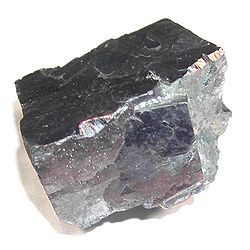Galena
| Galena | |
|---|---|
 Galena crystal from Galena, Kansas | |
| General | |
| Category | Sulfide minerals |
| Chemical formula | PbS |
| Strunz classification | 02.CD.10 |
| Dana classification | 2.8.1.1 |
| Crystal symmetry | 2/m 3 2/m |
| Identification | |
| Molar mass | 239.3 |
| Color | lead gray, silvery |
| Crystal habit | cubes and octahedra, tabular and sometimes skeletal crystals |
| Crystal system | cubic |
| Twinning | contact and penetration |
| Cleavage | cubic |
| Fracture | subconchoidal |
| Mohs scale hardness | 2½–2¾ |
| Luster | metallic |
| Streak | lead gray |
| Diaphaneity | opaque |
| Specific gravity | 7.2–7.6 |
| Fusibility | 2 |
| References | [1][2][3] |
Galena is the natural mineral form of lead sulfide. It is the most important lead ore mineral.
Galena is one of the most abundant and widely distributed sulfide minerals. It crystallizes in the cubic crystal system often showing octahedral forms. It is often associated with the minerals sphalerite, calcite and fluorite.
Lead ore deposits
Galena deposits often contain significant amounts of silver as included silver sulfide mineral phases or as limited solid solution within the galena structure. These argentiferous galenas have long been the most important ore of silver in mining. In addition zinc, cadmium, antimony, arsenic and bismuth also occur in variable amounts in lead ores. Selenium substitutes for sulfur in the structure constituting a solid solution series. The lead telluride mineral altaite has the same crystal structure as galena. Within the weathering or oxidation zone galena alters to anglesite (lead sulfate) or cerussite (lead carbonate). Galena exposed to acid mine drainage can be oxidized to anglesite by naturally occurring bacteria and archaea, in a process similar to bioleaching [4]
Galena deposits are found in Wales, Germany, France, Romania, Austria, Belgium, Italy, Spain, Scotland, Ireland, England, Australia, and Mexico. Noted deposits include those at Freiberg, Saxony; Cornwall,The Mendips, Somerset, Derbyshire, and Cumberland, England; the Sullivan Mine of British Columbia; and Broken Hill, Australia. Galena also occurs at Mount Hermon in Northern Israel. In the United States, it occurs most notably in the Mississippi Valley type deposits of the Lead Belt in southeastern Missouri, and in the Driftless Area of Illinois, Iowa and Wisconsin. The economic importance of galena to the early history of the Driftless Area was so great that one of the towns in the region was named Galena, Illinois.
Galena also was a major mineral of the zinc-lead mines of the tri-state district around Joplin in southwestern Missouri and the adjoining areas of Kansas and Oklahoma. Galena is also an important ore mineral in the silver mining regions of Colorado, Idaho, Utah and Montana. Of the latter, the Coeur d'Alene district of northern Idaho was most prominent. Galena is the official state mineral of the U. S. states of Missouri and Wisconsin.
The largest documented single crystal of galena measured 25x25x25 cm3.[5]
Galena uses
One of the earliest uses of galena was as kohl, which in Ancient Egypt, was applied around the eyes to reduce the glare of the desert sun and to repel flies, which were a potential source of disease.[6]
Galena is a semiconductor with a small bandgap of about 0.4 eV which found use in early wireless communication systems. For example, it was used as the crystal in crystal radio sets, in which it was used as a point-contact diode to detect the radio signals. The galena crystal was used with a safety pin or similar sharp wire, which was known as a "cat's whisker". Making such wireless sets was a popular home hobby in Britain during the 1930s. Derbyshire was one of the main areas where Galena was mined. Scientists that were linked to this application are Karl Ferdinand Braun and Sir Jagdish Bose. In modern wireless communication systems, galena detectors have been replaced by more reliable semiconductor devices, though silicon point-contact microwave detectors still exist in the market.
References
- ↑ Galena, <http://www.webmineral.com/data/Galena.shtml> (accessed 4 December 2009), WebMineral.com.
- ↑ Galena, <http://www.mindat.org/show.php?id=1641> (accessed 4 December 2009), MinDat.org.
- ↑ Galena. In Handbook of Mineralogy, <http://rruff.geo.arizona.edu/doclib/hom/galena.pdf>.
- ↑ Kinetics and mechanism of the bacterial and ferric sulphate oxidation of galena. Hydrometallurgy, <http://www.sciencedirect.com/science?_ob=ArticleURL&_udi=B6VBT-4D75MX0-1&_user=10&_rdoc=1&_fmt=&_orig=search&_sort=d&view=c&_acct=C000050221&_version=1&_urlVersion=0&_userid=10&md5=f0a90eb652838f319a5aba270e7c76ae>.
- ↑ Rickwood, Peter C. The largest crystals. American Mineralogist 1981, 66, 885–907, <http://www.minsocam.org/ammin/AM66/AM66_885.pdf>.
- ↑ The Art of Medicine in Ancient Egypt; Metropolitan Museum of Art: New York, 2005; p 10. ISBN 1-58839-170-1.
Further reading
- Klein, Cornelis; Hurlbut, Cornelius S., Jr. Manual of Mineralogy, 2nd ed.; Wiley, 1985; pp 274–76. ISBN 0-471-80580-7.
External links
- Case Studies in Environmental Medicine (CSEM): Lead Toxicity
- ToxFAQs: Lead
- Mineral information institute entry for lead
| Error creating thumbnail: Unable to save thumbnail to destination | |
This page was originally imported from Wikipedia, specifically this version of the article "Galena". Please see the history page on Wikipedia for the original authors. This WikiChem article may have been modified since it was imported. It is licensed under the Creative Commons Attribution–Share Alike 3.0 Unported license. |